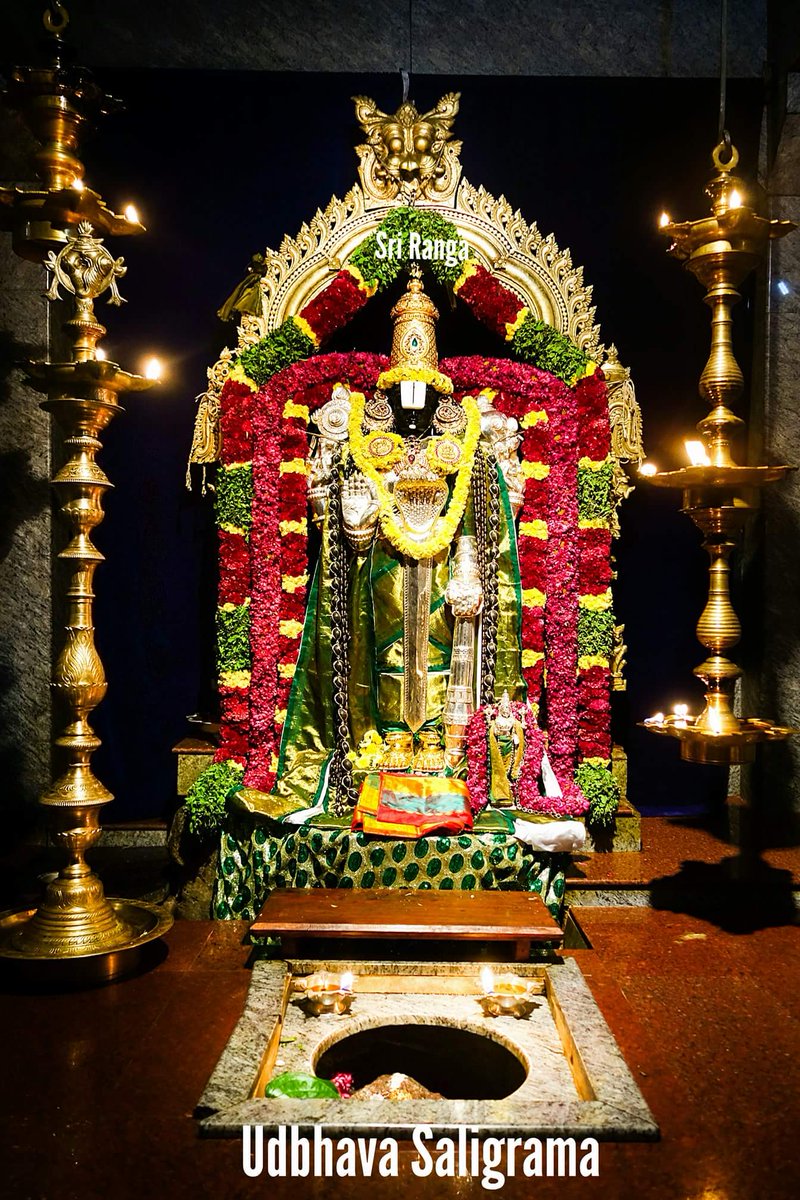
Magadi Ranganatha Swamy Temple is in a town called Magadi of Ramanagara district in the state of Karnataka. The temple is known for the constantly growing vigraha of Lord Ranganatha out of a granite slab.
Magadi is known by various names such as Mandavya Kshetra, Swarnachala, Swarnadri and Tirumale. The name Magadi is the apabhransha of Mandavya Kuti – the hermitage of sage Madavya. From Mandavya Kuti the name became as Makuti and then Magudi and finally as Magadi.
Magadi has vast history, splendours, rich culture, divine realm, natural treasures and the sacred Kanva river. It has also been the tapo bhumi of great sages like Mandavya, Kanva, Shuka Muni etc.
The origin of Magadi Ranganatha Swamy Temple
Magadi kshetra is mentioned in the Brahmanda Purana narrating its greatness and the presence of Lord Srinivasa here.
Once sage Mandavya went to Tirumala. There he performed tapasya to please Lord Srinivasa. Pleased by his tapasya Lord Sri Venkatachalapathi gave him darshan and said to sage Mandavya that he should go to Swarnachala and worship Him there to receive His blessings.
Hearing this from Lord Srinivasa the sage Mandavya came to Swarnachala (current day Magadi), built a hermitage here, undertook penance and received the blessings of Lord Sri Srinivasa. As per the instructions of the Lord, Sage Mandavya installed Lord Sri Venkatachalapathy in Swarnadri, facing west.
One who cannot visit Tirumala can come to Tirumale of Magadi to have darshan of Lord Sri Venkatachalapathy. Here Lord Srinivasa will bestow all happiness and grace to His devotees.
The History of Magadi Ranganatha Swamy Temple
The Magadi town was built by Cholaraja in the 11th – 12th century. Magadi Ranganatha Swamy Temple was built in the Dravidian style during the Chola period and later developed and expanded by many kings of Kingdoms of Hoysala, Vijayanagara, and by the descendants of Kempegowda. And especially during the Mysuru reign by Sampajaraya, Immadi Kempegowda and Doddaveerappa Gowda.
To facilitate the worship of the Lord, many kings have donated lands, jewelery, money to the temple which is all recorded in the inscriptions well preserved in the temple. On the far side of this shrine the inscriptions of 1514 AD and 1578 AD are present. Along with few more historical records, the Lord here is known as ‘Thiruvangalanatha’. Later in 17th century, He became famous as Sri Ranganatha Swamy.
The main mantapa of temple was built by Nagireddy. The latest gopura in Saracenic style was built by a Muslim devotee named Khiledar. At the western and eastern gates of the temple, there are two Raj Gopuras that represent the existence of Tirumale from far distance.
Mysteries of Lord Magadi Ranganatha swamy Temple
One of the specialities of this temple is presence of only deity of Sri Ranganatha Swamy who is 4.5 feet tall and outshines the elements of Vijayanagara style. The vigraha of the Lord is facing West direction. All the other deities in the temple complex are facing East.
Right in front of Magadi Ranganatha Swamy is the swayambhu shaligrama shila which was worshipped by Sage Mandavya. No matter how much water is used here for worship, no one knows where it goes.
The incredibly beautiful utsava murthy of Lord Ranganatha and Sridevi can be seen in the Navaranga. On the left (backside) of Sri Ranganatha Swamy, one can have darshan of Ammanavaru, Sita Devi, the huge carvings of Hanuman-Garuda and other deities of Sri Rama, Ramanujacharya, Alvars and Vaishnava devotees, all worshiped in their own altars.
The mysterious feature of Magadi Ranganatha Swamy temple is the Growing Ranganatha who is known as Beliyuva Ranga, Magadi Ranga, Makkala Ranga and Mula Ranga. This vigraha is a bas relief and is constantly growing out of the stone slab.
Festivals celebrated in Magadi Ranganatha Swamy Temple
Sri Magadi Ranganatha Swamy Brahma-Rathotsava is held every year during Chaitra Masa in Uttara Nakshatra before the full moon. At the same time, there are dedicated events which are celebrated for four days.
The Temple Timings of Magadi Ranganatha Swamy Temple
Magadi Ranganatha Swamy Temple is open throughout year every day from
Morning 8:30 AM to 1:00 PM to Evening 4:30 PM to 7:30 PM
The best time to visit Magadi Ranganatha Swamy Temple
The temple can be visited all through out the year. Festival days are generally crowded as it is the most prominent temple in this area.
How to reach Magadi Ranganatha Swamy Temple?
The best way to reach temple is to join Tirtha Yatra and get your tour organized.
By Road: Magadi Ranganatha Swamy Temple is 45 km from Bengaluru, 140 km from Mysuru. These cities are well connected by good roads. Road transport can be easily availed. Regular bus services and taxis are also available from Bengaluru.
By Rail: Bengaluru railway station is the nearest railway station. It is well-connected by important towns of India.
By Air: The nearest airport is at Bengaluru. Buses and private taxies are available from these airport location
Temples near Magadi Ranganatha Swamy Temple
Sri Narasimha Swamy hill, popularly known as the ‘Satmbha Giri’, is located on the right side of the Sri Magadi Ranganatha Swamy Temple.
Yoga Narasimha Swamy Temple where the Lord is in a pillar form. He is known as Kambada Narasimha Swamy which was installed by King Prahalad Maharaj.
Sri Prasanna Someshwara Temple, Sri Prasanna Rameshwara Temple, Sri Kotte Rameshwara Temple, Shri Kashi Vishwanatha Temple which are in Magadi town.
Savandurga hill also called as ‘Savinadurga’ or the Fort of Death, because of the steep incline and defence structure. Veerabhadreshwara Swamy and Narasimha Swamy temples are situated at the foothills of Savandurga.
1










Comment On Magadi Ranganatha Swamy Temple
manjunatha
ಸ್ವಾಮಿ ಮಾಗಡಿ ರಂಗನಾಥ ಶನಿವಾರ ರಾತ್ರಿಯೊಳಗೆ ನನ್ನ ಕೈ ಕಾಲಿಗೆ ಶಕ್ತಿ ನೀಡಿದರೆ 7 ಶನಿವಾರ ಅಭಿಷೇಕ ಸೇವೆ ಸಲ್ಲಿಸುವೆ.